The day has come! You are finally visiting Poland and want to know what traditional food to try? Take a look at our guide to Polish typical dishes and be ready for a hearty feast! One thing you should definitely remember - ALWAYS approach your dinner with an empty stomach as Polish cuisine is rich and very generous in portions. So all you foodies out there, are you ready? A little and fair warning before you start reading - you will get hungry within seconds… So let us begin with:
1. Polish bread
When Poles travel abroad this is something they miss most - Polish bread. Bread, the king ruling on all Polish tables, has been our staple food for centuries, and is still treated with great respect in Poland. There are certain customs that people still observe here. Let me give you an example: when a slice of bread falls on the floor you should pick it up and kiss it, beside that you should never throw away any bread… There are many others. So what is so special about traditional Polish bread? First of all, it is not fluffy and light. It is made of rye or wheat flour and sourdough. It needs time and patience to make it. But when it is ready - the crunchy crust and the unforgettable aroma… Once you’ve tried Polish sourdough bread you will never go back to another! And it stays fresh and delicious for about a week!
2. Herring
Let’s go forward now with the most popular starter on the Polish table - namely the herring! In Polish śledź or affectionately śledzik meaning "small herring", is a highly appreciated and popular fish in Polish cuisine. Can be prepared in all kinds of ways, the most popular one is marinated in vegetable oil with onions and pickled cucumber. Excellent with a glass of vodka, due to the contrast of flavors. More about drinking culture in Poland and ways to approach Polish vodka and not to lose completely you can read here.
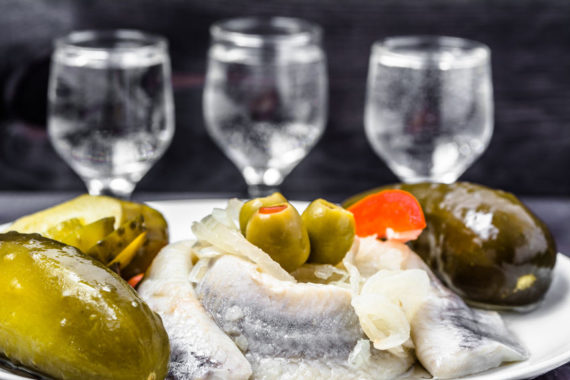
3. Pickles
Simply essential in traditional Polish cuisine! Pickled cucumbers, pickled cabbage, pickled beetroots… The truth is one can pickle almost any vegetable. On one hand pickles provide this characteristic sharp taste and constitute a perfect side dish (or a starter), on the other they were (and are still) the perfect source of vitamins and minerals during long Polish winters of the past.
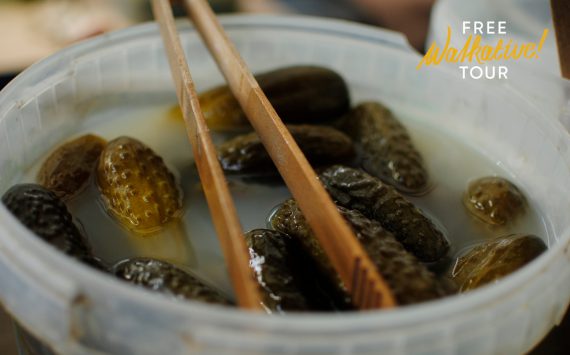
4. Kiełbasa or Polish sausage
Smoked fine meat, seasoned with pepper and garlic, can be eaten as a starter, on a sandwich (but remember Poles eat only open faced sandwiches, called kanapki!) or fried. Ideally it is fried on a stick over a campfire or grilled during garden parties in summer: parties that usually bring together many friends and family members. Its smell will also guide you through the streets of Polish cities as it is one of the star dishes of Polish Food Trucks. Remember to always eat it with mustard, accompanied by a pickled cucumber!
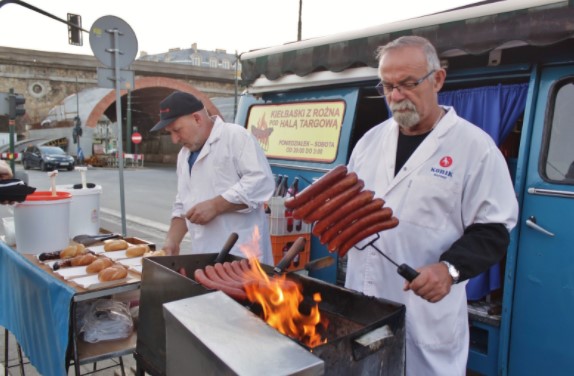
5. Kaszanka
Black pudding; buckwheat, blood and offal in an intestine casing. Served hot, fried over a campfire or grilled (just like kiełbasa); great with ogórek kiszony (sour pickles).
6. Oscypek
Smoked cheese made of salted sheep’s milk characteristic for the Tatra Mountains region, since 2007 protected by the EU as a traditional specialty. The oscypek artisans are the Górale, Polish highlanders, one of Polish ethnic minorities. To know more about them and their unique culture take a trip to Zakopane where you can find our tours! You can book them right here.
Oscypek is a delight for the palate, salty, smoked and delicious when baked or barbecued, toasted a little and accompanied by a cranberry jam! It never makes its way to a sandwich as it is simply too good to be eaten like this. But it is a perfect snack with a beer!

7. Soups
For me this is another thing I simply cannot live without - Polish soups. Did you know that in Polish cuisine there are more than 200 different kinds of them? They vary from region to region but let’s take a look at the ones you simply have to try:
Meat broth – every true Pole will eat it on Sunday dinner as a first course. The traditional broth is made of three different meats, usually chicken, veal and beef simmered for a couple of hours with vegetables and herbs. It comes with thin noodles.
White borscht, sour rye soup that comes with egg, mushrooms and sausage. Uniquely Polish, no other nation in the world does that: ferment flour for a soup. We do! And it makes a perfect comfort food!
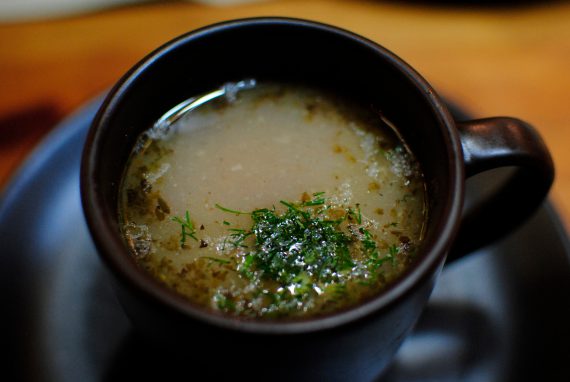
Red borscht, beetroot soup; can be served solo (as a hot drink); with krokiet – fried breaded pancake stuffed with meat and mushrooms; with uszka – small, ear-shaped dumplings stuffed with meat or mushrooms (the ones with mushrooms are served during Polish Wigilia (Christmas Eve). Again it is made with fermented liquid made of beets, salted water, herbs and spices. This liquid is called zakwas and can be drunk raw as it is super healthy!
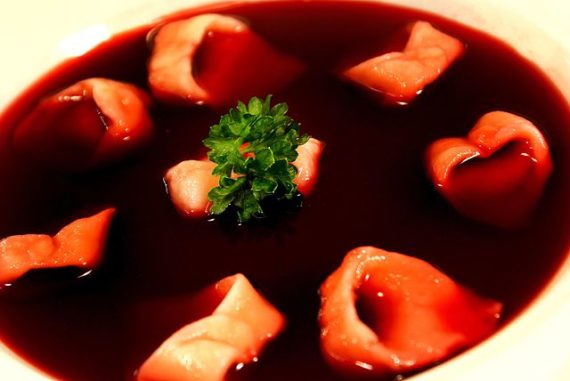
A soup made of shredded, Polish-style soured cucumbers and vegetables. Yum! One of my favourites!
A perfect soup for summer as you eat it chilled, its base is cooked beet leaves mixed with sour milk or sour cream (or yoghurt or buttermilk) with raw pickles, dill and a hard-boiled egg. And why litewski? It means Lithuanian, as the origins of this dish come from over there and Poland and Lithuania were united for several centuries. But that’s a different story... As you can see, traditional Polish food can tell you also much about Polish history.
Traditional beef tripe and spices stew; a famous remedy for hangovers.
Ok, these are just a few examples, I cannot write here about all 200 of them… Now let’s move to a second course.
8. Pierogi
We have to start with pierogi - the Polish dumplings, a dish famous all around the world. There are thousands of recipes for the dough but it is basically flour and water (sometimes eggs or boiled, mashed potatoes) with different fillings. When we eat them at home they are usually simply boiled in salted water. The word pierogi is already plural, so it is technically unnecessary to say “pierogies”. Every Pole is reminded of their youth days at home when eating them. And every Pole has their favourite ones. There are so many to choose from, so which ones should you try? Here are the most traditional versions:
- ruskie - with potatoes and cottage cheese;
- with pork meat;
- with cabbage and mushrooms, these are always served during Polish Wigilia (Christmas Eve);
- with fruits, strawberries or blueberries, eaten usually during Summer when fruits are fresh.
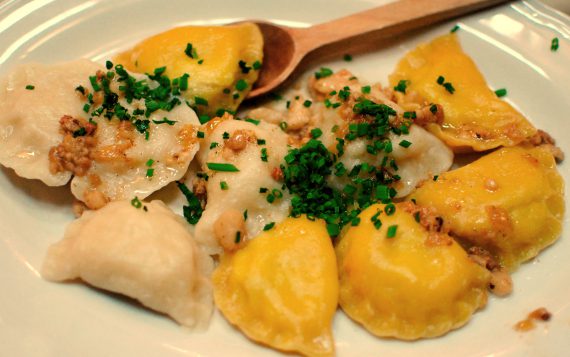
9. Kotlet schabowy
Breaded, fried (sometimes on lard) pork chop, a Polish schnitzel. It is a Sunday star dish - the most popular main course, commonly eaten on Sunday during a family meal. Always served with boiled potatoes and one of the cabbage side dishes: either fried cabbage - kapusta zasmażana or kapusta kiszona – sauerkraut, Polish style pickled cabbage.
10. Bigos
Hunter’s stew, single pot dish, usually made in winter months or on special occasions. Made of stewed sauerkraut and fresh cabbage with different kinds of meat and mushrooms, served with bread or potatoes. Called hunter’s stew as once every nobleman going hunting would take it with them. It gets better and tastier with time - after reheated and refrigerated a couple of times as it allows flavours to combine.
11. Gołąbki (literally, “small doves”)
Polish stuffed cabbage rolls, sometimes spelled wrongly “galumpki.” It is basically minced pork mixed with rice or buckwheat with onions, mushrooms and spices wrapped in a roll of white cabbage leaves braised in fat before serving. Comes with tomato or mushroom gravy. They taste best on the second or even third day!
12. Kasza
Known in American English as kasha, introduced to the language by the Jews from Central-Eastern Europe; whole-grain buckwheat, a staple of the traditional Polish diet. Can be eaten with meat stew or vegetables.
13. Racuchy
Can you imagine having a dessert as a main dish? Well, Poles do it all the time, especially during Summer! I already mentioned fruit pierogi but this dish I love the most. Racuchy are small cakes with a terrific smell and taste. Made of flour, fresh or sour milk, and yeast, then fried until golden with a sliced or grated apple (often with cinnamon or cloves); served sprinkled with powdered sugar.

Polish traditional desserts & iconic Polish sweet treats
Yes, from racuchy we now smoothly move to the “sweet ending” of your Polish meal. So here it goes, our favourite pastries, cakes and sweet treats:
14. Drożdżówka
Sweet roll, made with drożdże (yeast), hence the name. Commonly eaten for breakfast, can be made with fruit, jam, sweet cottage cheese and poppy seed. Especially delicious are jagodzianki, made during summer with blueberries (in Polish jagody). Well, to be honest I am sure that Polish pastries are something you will dream of after returning home and will never forget!
15. Pączki
Polish doughnuts, deep-fried, round pieces of dough, filled with confiture and covered with icing. The best and most traditional ones are filled with wild rose petals jam. Poles eat way too many of them during Fat Thursday, just before the beginning of Lent. But well, this is an old Polish tradition and we are known for respecting our traditions (especially sweet ones like this!).

16. Kremówka
Cake made of two layers of puff pastry with custard cream. Favourite cake of John Paul II, who as a boy would bet with his colleagues who can eat more of them.
17. Sernik
Cheesecake. Traditional Polish cheesecake is made from grounded fat cottage cheese with dried fruit and chocolate icing.
18. Szarlotka
Apple pie. To say that apples are big in Poland is to say nothing. Poles love their national fruit, grow tonnes of it and make all sorts of things out of it. We are the second biggest producer of apples in Europe and the fourth in the world after China, USA and Turkey. There are countless recipes for apple cakes but they all taste even better when served warm with ice cream.
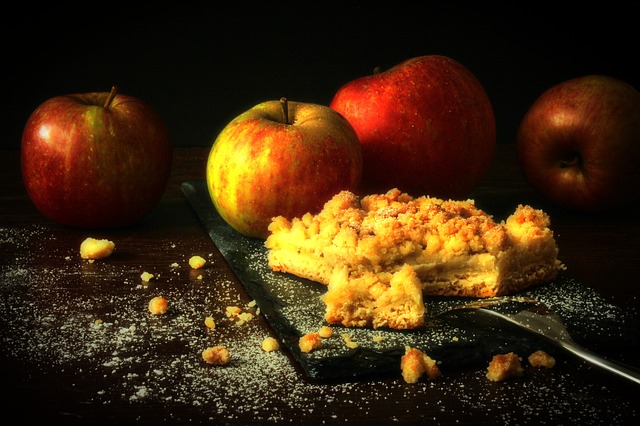
19. Makowiec
Poppy seeds cake, typically eaten during Christmas but not only. Made with yeast, cooked, grounded (usually three times) poppy seed and delicacies. According to folk tradition, eating makowiec would bring happiness and girls who ground poppy seeds would get married quickly. A little extra piece of information - I’ve heard that this is the favourite cake of Roman Polański, Polish movie director. More about him and iconic Polish movies you can read here or learn during our Hollyłódź tour that takes you through Łódź, Polish city famous for its Film School. Check it out here.

20. Malaga, Tiki Taki, Kasztanki
Legendary pralines from Wawel chocolate factory, filled with raisins, nuts & coconut, crunchy wafer & cocoa. Growing up under communism this was what all the kids were dreaming about.
21. Michałki Białe
Pralines filled with cocoa and chopped peanuts covered with white chocolate from Wawel chocolate factory.
22. Krówki
Polish fudge; semi-soft milk toffee candies.
23. Ptasie Mleczko
A soft chocolate-covered candy filled with soft meringue, comes in many flavours.
24. Prince Polo
Polish chocolate wafers, produced since the 1950’. Besides Poland loved also in Chech Republic, Slovakia, Hungary, Ukraine and… Iceland. Well, Poland would import loads of herring from Iceland and the Icelanders couldn’t get enough of Polish Prince Polo, known there as “Prins Póló.” Seems fair right?
If you want to try those dishes we have a perfect option for you: our own Walkative! Food and Vodka Tour! Go on, do your palate and stomach a big favour and book it right now! We can’t wait to see a content smile on your face!
To be honest I love Polish cuisine and I could go on and on but writing this text made me really hungry and I seriously have to go and eat something! So that is all for now.
Yours truly,
Gosia
P.S. We have a text about Polish regional food as well, if you feel you don’t have enough. Find it here.






